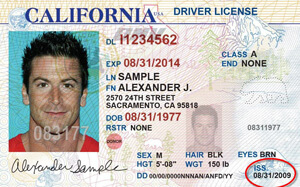- Updated for March 2025
- Based on 2025 CA commercial driver's license manual
Free California CDL Permit Practice Test: General Knowledge 2025
The great state of California can offer numerous economic opportunities to commercial drivers because of its diverse economy, the largest in the United States. California produces about one-seventh of America’s Gross Domestic Product (GDP). Key economic sectors dependent on truck driving include agriculture (the Central Valley), manufacturing, trade, and transportation. The Port of Los Angeles is the nation’s largest seaport, and the Port of Long Beach is the second largest. Together, they bring in about 40% of America’s imports. Note: Seaports, like airports, are secure areas. You may need to obtain a Transportation Worker Identification Credential (TWIC) card to pick up cargo there. Finally, the tourism and hospitality sectors employ bus drivers to take visitors to the state’s many points of interest.
Key commercial routes for transporting goods within the state and to neighboring states include Interstates 5, 10, 15, and 80; US Route 101, which goes from Los Angeles to the Oregon border; and State Route 99, which goes through the Central Valley.
Before you can obtain a Commercial Driver’s License (CDL), you must obtain a Commercial Learner’s Permit (CLP), which will allow you to practice commercial driving under the supervision of a licensed CDL holder. An important step toward obtaining the CLP is to pass the official General Knowledge test on commercial driving theory. Have you been studying the official California Commercial Driver Handbook (California CDL Handbook 2025)? You certainly should because the questions on the official knowledge test are based on it. However, you’re probably here because you want to get a little more help to pass the knowledge test than you’re getting from this driving manual. We can help, just as we’ve helped thousands of other aspiring drivers.
This free California CDL permit practice test, which you’re about to take, is based on the official state manual, just like the official knowledge test. It’s up to date as of March, 2025. There are 50 multiple-choice questions on such topics as basic driving techniques, commercial driving regulations, emergency preparedness, and pre-trip inspections. Unlike the official knowledge test, this practice test comes with our automated assistant. It can give you a hint if you get stuck on a question and an explanation of the correct answer if you still miss the question. Please read the explanation so you won’t make the same mistake in the future What this practice test doesn’t come with is a time limit. Take your time to improve your chances of passing the test and learn as much as you can from the experience.
- Perfect for first-time and renewal CDL/CLP applicants, and those adding endorsements
- Triple-checked for accuracy
What you need to know

What to expect on the actual CA DMV exam
questions
correct answers to pass
passing score
List of questions (classic view)
- Which of these will cause you to lose your CDL for a minimum of one year for the first offense?
- Which of these is not a possible penalty for having more than one license?
- According to the state of California, you are considered involved in interstate commerce UNLESS the cargo you are transporting
- In a seven-day period, you are permitted to drive a maximum of ___ hours.
- What must you do if you are involved in a collision that involves death, injury, or property damage over $1,000?
- Within how many days must you notify your employer of any traffic violations (except parking)?
- According to the state of California, what is the most important and obvious reason to check your vehicle?
- Which of these is part of the seven-step inspection method?
- Which of these should you do during a trip as part of your en route inspection?
- During a seven-step inspection, checking the engine compartment does NOT include checking
- You check your safety belt to ensure that
- The steps for checking your signal lights include the following
- Which of these is NOT a rule to follow for backing safely?
- Which of these is NOT part of the basic method for shifting up?
- How far ahead do most good drivers look, according to the Handbook?
- Retarders
- Which of the following is NOT a proper way to signal?
- Where should you place your warning devices, if you must stop on a one-way or divided highway?
- Which of these equals the total stopping distance?
- What is the safest speed when you are driving in heavy traffic?
- Which of the following should you NOT do when you are being tailgated?
- Which of these statements is true about the relationship between cargo and height?
- Which of these is not a problem associated with other drivers during night driving?
- Which of these are signs of a driver under the influence?
- Which of the following should you NOT do while driving at night?
- Which of the following should you NOT do if you experience a tire failure?
- An antilock braking system (ABS) will
- Which of these should you NOT do during a drive wheel skid?
- If you are involved in a collision, you should
- Which of these is NOT a common cause of vehicle fires?
- An A: B: C type fire extinguisher is designed to work on which types of fires?
- To help you stay alert and safe while driving, you should
- Which of the following is NOT a main concern when you are driving in very hot weather?
- Your vehicle is stuck on railroad tracks. You should
- According to the Handbook, children present a hazard because
- You don't want to be a distracted driver, so you
- Step 3 of the seven-step inspection method is Start Engine and Inspect inside the Cab. This step involves each of the following tasks, EXCEPT
- Your safety equipment must include
- On wet roads, you should reduce your speed by
- Checking your vehicle's suspension does NOT include checking
- At what speed should you test the stopping action of the service brakes?
- Which of the following is NOT a basic skill needed to operate a commercial vehicle?
- When you back with a trailer, you should
- During your pre-trip test, when examining hoses with the instructor, you need to look for
- After your pre-trip inspection, you should inspect your cargo
- A top-heavy load is dangerous because it can cause
- The aggregate working load limit of your cargo tiedowns must be at least ______ times the weight of the cargo.
- Flags or lights are required on projecting loads that extend
- What is the gross vehicle weight (GVW)?
- Legal maximum weight limits may not be safe in all of the following, EXCEPT
FAQs
How can you obtain a CDL license?
To obtain a CDL license in California, first acquire a commercial learner's permit (CLP) by passing the necessary knowledge tests. Hold the CLP for at least 14 days before taking the skills test. While CDL training is not mandatory, it's recommended for better preparation. Then, pass the skills test to get your CDL.
Is CDL training mandatory?
CDL training is not mandatory in California, but attending a training school is highly recommended. It provides comprehensive preparation for the skills test and better equips you for commercial driving.
How long does CDL training last?
CDL training duration varies by program in California. It typically ranges from a few weeks to several months, depending on the type of license and full-time or part-time training schedules.
What is the cost of getting a CDL?
The cost for a CDL in California includes a $73 application fee, plus additional costs for medical examination, training programs, and the skills test. Training costs vary depending on the school and program chosen.
What disqualifies you from getting a CDL?
In California, disqualifications from obtaining a CDL include serious traffic violations (like DUIs), major at-fault accidents, criminal convictions related to motor vehicle operation, and failing the required medical exam.
- Alabama: Test 1 / Test 2
- Alaska: Test 1 / Test 2
- Arizona: Test 1 / Test 2
- Arkansas: Test 1 / Test 2
- California: Test 1 / Test 2
- Colorado: Test 1 / Test 2
- Connecticut: Test 1 / Test 2
- Delaware: Test 1 / Test 2
- District of Columbia: Test 1 / Test 2
- Florida: Test 1 / Test 2
- Georgia: Test 1 / Test 2
- Hawaii: Test 1 / Test 2
- Idaho: Test 1 / Test 2
- Illinois: Test 1 / Test 2
- Indiana: Test 1 / Test 2
- Iowa: Test 1 / Test 2
- Kansas: Test 1 / Test 2
- Kentucky: Test 1 / Test 2
- Louisiana: Test 1 / Test 2
- Maine: Test 1 / Test 2
- Maryland: Test 1 / Test 2
- Massachusetts: Test 1 / Test 2
- Michigan: Test 1 / Test 2
- Minnesota: Test 1 / Test 2
- Mississippi: Test 1 / Test 2
- Missouri: Test 1 / Test 2
- Montana: Test 1 / Test 2
- Nebraska: Test 1 / Test 2
- Nevada: Test 1 / Test 2
- New Hampshire: Test 1 / Test 2
- New Jersey: Test 1 / Test 2
- New Mexico: Test 1 / Test 2
- New York: Test 1 / Test 2
- North Carolina: Test 1 / Test 2
- North Dakota: Test 1 / Test 2
- Ohio: Test 1 / Test 2
- Oklahoma: Test 1 / Test 2
- Oregon: Test 1 / Test 2
- Pennsylvania: Test 1 / Test 2
- Rhode Island: Test 1 / Test 2
- South Carolina: Test 1 / Test 2
- South Dakota: Test 1 / Test 2
- Tennessee: Test 1 / Test 2
- Texas: Test 1 / Test 2
- Utah: Test 1 / Test 2
- Vermont: Test 1 / Test 2
- Virginia: Test 1 / Test 2
- Washington: Test 1 / Test 2
- West Virginia: Test 1 / Test 2
- Wisconsin: Test 1 / Test 2
- Wyoming: Test 1 / Test 2
Your go-to, trusted source
Experience the Driving-Tests differenceOur commitment to accuracy and quality in our practice tests
Explore our rigorous, multi-tiered verification process that ensures each question mirrors the official manual for unparalleled accuracy.

At Driving-Tests.org, we understand the importance of reliable and accurate practice tests to help you prepare for your DMV exam. That's why we've developed a meticulous process to create and continually update our practice questions, ensuring they reflect the most current driving laws and regulations.
Here's an inside look at how we maintain the highest quality in our practice tests.
Content Creation and Verification Process
- Alignment with Official Manuals:
Every question we develop is based on the most recent version of each state's official driving manual. Our team regularly monitors each state DMV's website for the latest updates to ensure our practice tests are always aligned with the most current information. - Community Feedback Integration:
We leverage feedback from our vast community of users to understand which topics are most frequently tested. This helps us focus on the areas that are most relevant and beneficial for your preparation. - Expert Content Creation:
Our in-house editor, Steven, who has extensive experience in driver education, crafts each question with precision. He conducts a thorough review of each question against the official manuals to ensure accuracy. - Rigorous Review Process:
Once Steven has finalized a set of questions, our team conducts a joint review session. This second level of scrutiny involves content accuracy, proofreading, and fact-checking to eliminate any errors. - User Feedback Mechanism:
After a question goes live on our site, we keep the lines of communication open. Each question features a feedback button, inviting users to report any issues or errors. This continuous feedback loop allows us to address and rectify any concerns promptly. - Responsive Updates:
In line with our commitment to accuracy, we quickly update our practice questions to reflect any changes in the DMV manuals. Additionally, we update the free electronic copy of the state's driver's license manuals on our site, typically within a few days after the DMV publishes them.
Our thorough quality control process ensures that you have access to practice tests that are as accurate and up-to-date as possible. We believe in the power of well-prepared drivers and are dedicated to providing you with the best study tools to help you succeed on your DMV exam.
Pass the First Time – Guaranteed
You’re moments away from your results.
Before you view them, see how 1.15 million drivers used Premium to pass faster.
Real Exam-Like California Questions
Get all exam-like questions seen on the real test.
99.06% Pass Rate vs. 49% Average
Most Premium users pass on their first try.
Money-Back Guarantee
We stand behind you until you pass.




